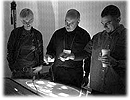Interactions: Description

Photo Credits
More than just papers, MW2005 offers a chance for dialogue.
| Workshops |
| Sessions |
| Speakers |
| Interactions |
| Demonstrations |
| Exhibits |
| Best of the Web |
| produced by
|
| Join our Mailing List Privacy Policy |
Creating a Hands-on Academic Classroom with Online Teaching Companions
Andy Mink, University of Virginia, USA
Amanda Robertson, Imedia - Instructional Media Design, USA
Joseph Covington, North Carolina Museum of Art, USA
http://www.vcdh.virginia.edu/
Mini-Workshop: Hands-on Classroom On-line
A successful hands-on classroom combines the science of directive teaching with the art of inquiry-based facilitation. Teachers provide context and information while students explore and construct interpretations that form a rich fabric of learning skills and habits of mind that lead to understanding and mastery of state-mandated curriculum.
Technology has fundamentally changed the landscape of teaching in one critical way: accessibility. Databases create a warehouse for a limitless quantity of primary sources on any topic while the internet gives users all over the world access to these documents with a click of the mouse. Public educators in the K-12 system are now able to access these documents, integrate them into daily classroom instruction, and give their students the opportunity to learn material by exploring, uncovering, and drawing conclusions from primary sources. For example, history students can immerse themselves in the same academic approach that a university scholar uses to research and publish historical content: identifying a historical problem, discovering primary sources of that event, and drawing conclusions based on that evidence. In addition to learning the material, students develop skills necessary to function as independent learners, of analyzing and synthesizing primary data, and for presenting their findings. Students are able to combine their real world exploration with access to the data, evidence, and documents that help them interpret and draw conclusions of these experiences. When students are given the opportunity to explore primary sources, the class itself transforms to a highly independent, problem-based classroom in which the individual student controls the direction, the pace, and the outcome of their study. Technology creates more opportunities for teachers and students to access information, but with that access comes the responsibility of redefining the classroom to emphasize, reward, and expect a different type of learning.
We will focus on how to combine digital technology with experiential methodologies in the K-12 education using an online teaching companion. We will offer specific classroom examples of how technology can improve the quality of teaching and content mastery for students. We will feature three online teaching companions: "Digital Resource Guide for American History" and "Tredegar National Civil War Museum" by the Virginia Center for Digital History at the University of Virginia and "ArtNC: Look, Learn, Teach" by the North Carolina Museum of Art. These exemplary models illustrate how university, community, and museum organizations can create online resources to further the exploration and teaching of academic content. Our goals are to inform educators on how to evaluate and implement interactive online technology to transform the way students learn academic content and to model new ways to approach a museum or other educational site design to facilitate active, participatory learning.
April 2005
analytic scripts updated:
October 2010
Telephone: +1 416 691 2516 | Fax: +1 416 352 6025 | E-mail:
